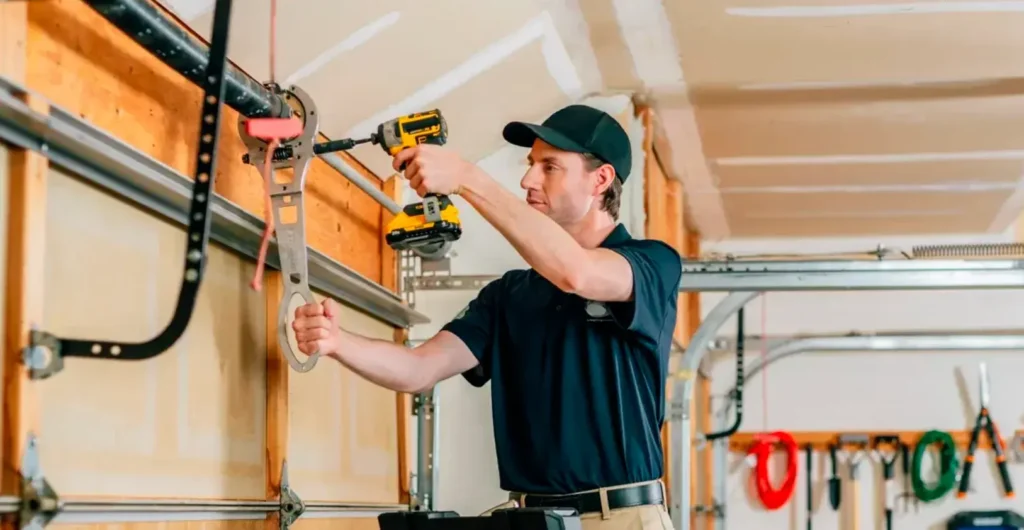The Green Bay Garage Door That Taught Me Precision
A few winters ago, I was called to a home on Green Bay’s east side.
The homeowner said, “My garage door opener keeps clicking, but the door barely moves.”
When I arrived, I found what I always dread — a torsion spring that had snapped clean in half.
But what struck me wasn’t the broken spring itself.
It was the way it broke.
One side of the torsion bar was wound tighter than the other, twisting under unequal pressure for months until it finally gave out.
That moment reminded me of something I’ve learned after decades in this work:
Garage door spring replacement isn’t about power — it’s about precision.
In this guide, I’ll share the essential repair strategies that make a garage door spring replacement not just safe, but successful — the same methods my team at WI Garage Door LLC uses to keep Green Bay homes running smoothly year-round.
1. Start With Balance — Always
Before I touch a wrench, I test the door’s balance.
Balance tells you everything — it reveals whether springs are fatigued, if the cables are uneven, and if the opener is compensating for lost tension.
Here’s my quick rule:
If you lift your garage door halfway and it drifts down or shoots up, you don’t need an opener adjustment — you need a garage door spring replacement.
An unbalanced door may still “work,” but it silently punishes every component — opener gears, hinges, rollers, even the tracks.
Proper balance is the foundation for every repair that follows.
2. Always Replace Both Springs, Not One
I see this mistake constantly: homeowners replace just the broken spring and leave the other untouched.
The logic seems sound — why fix what isn’t broken?
But here’s the reality:
Both springs share equal workload and cycle life.
If one fails, the other is just a few turns away from breaking too.
At WI Garage Door LLC, we always replace both during a garage door spring replacement because symmetry equals safety.
When both springs are calibrated together, the door moves smoothly and the torsion bar stays straight — protecting your entire system.
3. Use the Right Spring for the Door — Not Just “Any” Spring
Not all garage doors weigh the same, and not all springs are created equal.
Each door has a unique combination of height, panel material, and insulation.
That means spring selection is a science — not guesswork.
Using a spring that’s too strong causes the door to shoot up uncontrollably; one that’s too weak makes it feel like lifting a small car.
During every garage door spring replacement, we measure:
- Door weight to the nearest pound
- Shaft diameter and length
- Cycle rating (10,000–50,000 cycles)
- Climate and corrosion factors
That’s how we ensure the perfect spring match — strong enough for durability, precise enough for smoothness.
4. Clean, Inspect, and Prep Before Installation
Replacing springs isn’t just about winding coils.
It’s about preparing the entire system to work in sync again.
Before installing new springs, I always:
- Clean the torsion shaft and apply light silicone lubricant
- Check the end bearings for wear or rust
- Tighten set screws and roller brackets
- Inspect the cables for fray or tension loss
Skipping these small steps is like changing tires without aligning the wheels — it works for a while, but not for long.
A full-system inspection ensures that your garage door spring replacement restores performance, not just motion.
5. Safety Comes From Control, Not Speed
One of the most important lessons I teach every technician:
“Speed gets you in trouble. Control keeps you safe.”
When winding torsion springs, I never rush.
We wind one quarter-turn at a time with calibrated bars, locking each position before proceeding.
Every garage door spring replacement carries risk — but discipline and control eliminate surprises.
By the time the final turn is made, we know that door is perfectly tensioned, aligned, and ready for another 10,000+ cycles.
6. The Counterintuitive Truth: Less Torque = Longer Life
It sounds backward, but it’s absolutely true — over-torquing a spring shortens its lifespan.
Springs are designed to flex within a precise tension range.
When wound too tightly, they lose elasticity faster and can even warp the torsion bar.
A proper garage door spring replacement aims for balance, not brute strength.
When the tension is just right, the opener barely feels the weight of the door — and that’s what makes a system last.
7. Calibrate for Perfection — The Professional Touch
Here’s where real expertise shows: calibration.
A proper garage door spring replacement doesn’t end when the springs are installed — it ends when the entire system moves as one.
That means:
- The door lifts evenly.
- The opener hums quietly with no strain.
- The torsion bar stays straight through every rotation.
To achieve that, we measure tension to within a quarter-turn.
Even a single over-rotation can throw the door’s weight distribution off.
Once the springs are set, we cycle the door multiple times — open, close, open again — and listen.
Quiet is the sound of precision.
When the door glides silently, you know the calibration is perfect. That’s the level of craftsmanship we bring to every garage door spring replacement in Green Bay.
8. How to Spot Post-Replacement Issues Early
Even after a professional install, your system still “settles in.”
As the springs adapt to daily cycles, small shifts can occur.
Here are a few early signs something might need a quick adjustment:
- The door closes too quickly: Spring tension slightly low.
- The opener hesitates or reverses mid-lift: Tension too high or limits off.
- New vibration or noise: Bearings or brackets loosening under new pressure.
If you notice any of these, don’t panic — it’s normal fine-tuning.
We offer free follow-up checks after every garage door spring replacement to ensure long-term balance and smooth operation.
9. Seasonal Care: How Green Bay Weather Impacts Spring Longevity
Green Bay homeowners know the cycle — freezing winters, humid summers, and salty air from plowed roads.
Each season brings a new challenge for steel springs.
Here’s how I recommend caring for your system year-round:
Spring & Fall
- Wipe away salt residue or moisture buildup near the bottom of the door.
- Apply silicone lubricant to springs and bearings to prevent friction.
- Schedule a quick tune-up to adjust for temperature-related expansion or contraction.
Winter
- Avoid forcing a frozen door open. The sudden tension surge can snap a spring instantly.
- Use a garage-safe heater to reduce metal brittleness.
Summer
- Inspect coils for surface rust and reapply corrosion protection if needed.
With regular seasonal attention, a professional garage door spring replacement can last far beyond its rated cycle life — often doubling its expected years of service.
10. The Counterintuitive Truth: Springs Don’t Lift the Door — Balance Does
Here’s something I tell every customer that usually surprises them:
Springs don’t “lift” the door — they create balance so gravity doesn’t win.
If your springs are correctly calibrated, you could disconnect the opener and lift the door with two fingers.
If you can’t, your system is out of sync.
That’s why we don’t just replace springs; we restore harmony between every moving part — the opener, cables, rollers, and tracks.
That harmony is what makes a garage door spring replacement last for years without strain or failure.
11. Avoiding the Biggest Mistake: Ignoring the Rest of the System
One of the most common errors I see is replacing springs without addressing the rest of the system.
A new spring on worn bearings or stretched cables is like new tires on a car with bad suspension — it won’t stay smooth for long.
That’s why every garage door spring replacement from WI Garage Door LLC includes a full 30-point safety inspection:
We check:
- Cable tension
- Drum wear
- Bearing condition
- Track alignment
- Opener force calibration
Each piece affects the others. You can’t have safety without system balance — and that’s exactly what our process guarantees.
12. The Mentor’s Perspective: It’s More Than a Spring — It’s a System
After decades of work in garages across Green Bay, I’ve learned that success in this trade comes down to one thing: respect for precision.
A proper garage door spring replacement isn’t about replacing a broken part — it’s about restoring the relationship between every component.
It’s about listening for friction, feeling the weight shift in your hands, and knowing exactly when the system “clicks” back into balance.
That’s the difference between a temporary fix and a lasting repair.
I tell every apprentice who joins WI Garage Door LLC:
“If it’s quiet, smooth, and effortless — that’s when you know it’s perfect.”
And that’s what we deliver to every homeowner we serve.
Final Thoughts: Green Bay’s Trusted Experts in Garage Door Spring Replacement
Whether your spring has snapped or your door just feels heavier than usual, don’t wait until it fails completely.
A professional garage door spring replacement is more than a repair — it’s protection for your door, your opener, and your safety.
At WI Garage Door LLC, we specialize in high-precision garage door spring replacement built for Wisconsin’s harsh climate.
Every service we perform combines safety, balance, and craftsmanship — ensuring your door operates smoothly for years to come.
Because when your door moves in silence, that’s not just good mechanics — that’s peace of mind.
Call WI Garage Door LLC — Green Bay’s trusted experts for garage door spring replacement, balance calibration, and preventive maintenance.
Safe. Smooth. Built to last.

